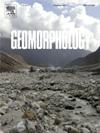Assessing the impacts of regulation works on an Upper Rhine reach for developing a process-based restoration framework
IF 3.1
2区 地球科学
Q2 GEOGRAPHY, PHYSICAL
引用次数: 0
Abstract
Historical studies are fundamental to the assessment of the effects of regulatory works on the functionality of river systems and to the definition of management strategies. The objective of this study was to evaluate the impact of engineering works conducted along the Upper Rhine River on an 11-km stretch between Offendorf (France) and Lichtenau (Germany). This was achieved through a before–after approach, with the aim of formulating functional restoration guidelines for future actions. This study employed historical maps, long-term water level data and groundwater level changes from 1830 to 2020 to quantify land cover changes from 1778 to 2021. Hand corings were conducted to estimate the thickness of fine sediments, while their spatial distribution and the calculation of fine sediment rates were performed using historical maps and an aerial topographic LiDAR survey. The results of this study demonstrate that engineering work has resulted in significant impoverishment of both aquatic and riparian habitats. This is due to the metamorphosis of the braided-anabranching channels and the associated gravel bars, which have undergone a transformation into a single narrow subrectilinear channel. The deterioration of lateral connectivity between the main channel and the floodplain after the correction works resulted in a reduction in the number of side channels and a contraction of these channels over time. Additionally, there was a homogenisation of the water channel typology related to terrestrialisation processes and dewatering of the channels. Following the Rhine correction, there was a notable decline in fine sediment deposition along the floodplain. The majority of this deposition occurred at low topographic points, which were found to correlate with the historical lateral displacement of the thalweg. Despite the considerable adverse effects of Rhine regulation, this study indicates that the link between the canalised Rhine and the floodplain may be regarded as viable, given the minimal bed incision and the consistent mean groundwater level over time. It may be beneficial to implement several bank-lowering operations of the canalised Rhine to rehabilitate lateral connectivity between the main channel and the floodplain, redynamise old side channels and improve ecosystem services.
求助全文
约1分钟内获得全文
求助全文
来源期刊

Geomorphology
地学-地球科学综合
CiteScore
8.00
自引率
10.30%
发文量
309
审稿时长
3.4 months
期刊介绍:
Our journal''s scope includes geomorphic themes of: tectonics and regional structure; glacial processes and landforms; fluvial sequences, Quaternary environmental change and dating; fluvial processes and landforms; mass movement, slopes and periglacial processes; hillslopes and soil erosion; weathering, karst and soils; aeolian processes and landforms, coastal dunes and arid environments; coastal and marine processes, estuaries and lakes; modelling, theoretical and quantitative geomorphology; DEM, GIS and remote sensing methods and applications; hazards, applied and planetary geomorphology; and volcanics.
 求助内容:
求助内容: 应助结果提醒方式:
应助结果提醒方式:


